Multi-page website using HTML, SCSS & Vanilla JS

Solution retrospective
Hey there Frontend Mentors! Thank you for looking at my solution. Any feedback would be greatly appreciated.
One issue that I struggled with and couldn't come up with a satisfactory solution is this: It looks like if you shrink an image by using "transform: scale()", the image appears smaller, but still occupies it's original dimensions. Is there any way to have their real dimensions change dynamically? For this challenge there were many images, of varying sizes, I needed to shrink and have next to each other. I ended up having to hardcode the width for each individual image. Is there a better solution to this problem?
Please log in to post a comment
Log in with GitHubCommunity feedback
No feedback yet. Be the first to give feedback on Jeuri Morel's solution.
Join our Discord community
Join thousands of Frontend Mentor community members taking the challenges, sharing resources, helping each other, and chatting about all things front-end!
Join our Discord